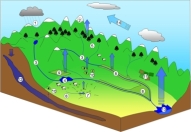Prof. Jason P. Evans
Climate Change Research Centre
University of New South Wales









On the non-stationarity of hydrological response in anthropogenically unaffected catchments: An Australian perspective.
Ajami, H., A. Sharma, L.E. Band, J.P. Evans, N. K. Tuteja, G. Amirthanathan and M. Bari
MODSIM2015, 21st International Congress on Modelling and Simulation. Modelling and Simulation Society of Australia and New Zealand, Gold Coast, Australia, 29 November – 4 December 2015. Abstract
Increases in greenhouse gas concentrations are expected to impact the terrestrial hydrologic cycle
through changes in radiative forcings (affecting precipitation and temperature) and plant physiological and
structural responses. Here we investigate the nature and frequency of non-stationary hydrological response as
evidenced through water balance studies over 166 anthropogenically unaffected catchments in Australia
using
data
from
the
Australian
network
of
Hydrologic
Reference
Stations
(http://www.bom.gov.au/water/hrs/). Non-stationarity of hydrologic response is investigated through analysis
of long term trend in annual runoff ratio (1984-2005). Results indicate that a significant trend (p < 0.01) in
runoff ratio is evident in 19 catchments located in three main ecoregions of the continent. Runoff ratio
decreased across the non-stationary catchments with the exception of one catchment in northern Australia.
Non-stationarity of runoff ratio is caused by complex interactions between changes in precipitation, climate
variability, plant physiological and structural responses to elevated CO 2, landscape characteristics (soil and
topography), and the hydroclimatic condition of a catchment. We use precipitation-productivity relationships
as the first order control for catchment classification under climate change. Monthly fractional vegetation
cover from the Advanced Very High Resolution Radiometer (AVHRR) sensor is used as a measure of
vegetation productivity. This first order grouping of catchments will help to generalize catchment behaviour
in terms of changes in runoff ratio and vegetation productivity due to changes in precipitation. Eleven out of
19 catchments present a positive precipitation-productivity relationship possibly enhanced by CO2
fertilization effect. In the remaining catchments, nutrient limitations may be impacting productivity. The
proposed classification framework provides a general guideline for projecting the likely changes in
catchment water balance in response to climate variability. However, uncertainty about the terrestrial
ecosystem response still remains as productivity is impacted by factors such as availability of water, nutrients
and light, vegetation developmental stage, space constraint and prevalence of pests. In addition, it is
expected that frequency and duration of extreme events such as fire, drought and floods to increase in future.
These changes are expected to further alter ecosystem response and water availability.
|
|